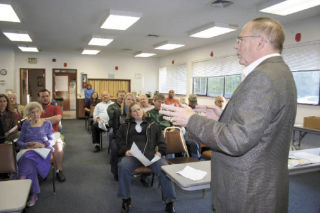Property owners fear losses
Tempers flared at a community-organized informational meeting Thursday night as a large group of incensed citizens voiced their disdain for a county ordinance addressing the Navy’s “aircraft accident potential zone.”
County Commissioner Mac McDowell, Planning Director Jeff Tate and Long Range Planner Anthony Boscolo, all of whom voluntarily attended the meeting to explain the process and rationale behind the new ordinance, were the recipients of the group’s mounting discontentment.
The crowd of roughly 40 citizens were respectful of the county trio as they explained the lengthy process rife with amendments that culminated March 10 with the commissioners’ approval.
McDowell emphasized that the density-regulating ordinance for properties lying within the APZ was not solicited by the Navy. He said the county, when updating its comprehensive plan as required by the Growth Management Act, evaluated the flight patterns and the properties lying within the “racetrack” formation.
“Accidents happen primarily when landing and taking off,” he said, referencing the diminishing margin of error as a plan loses altitude.
But the bulk of the residents lamented the perceived lack of proper notice given to the public during the process. A number of attendees were unaware of the genesis of the ordinance and even of its existence.
Tate explained that public hearings were held and advertised in the legal sections of four newspapers. When the Island County Planning Commission first took on the GMA update, the planning director said significant public testimony led to language changes and even modified subdivision rules.
Many of the attendees beseeched the county to hold itself to a higher level of accountability by disseminating information about public hearings well in advance and in more obvious locations or publications.
“Jeff, do you find that adequate?” asked Mark Lugo regarding the fine-print legal postings. “It’s disappointing that the county wouldn’t take into consideration the landowners and assume they will pick up the paper.”
“You could have stuck it on our tax bill,” quipped Angie Leets.
Lugo also questioned the timing of the regulations, wondering out loud why the public was not heard or allowed to vote. And why the issue was not brought forward prior to March 10.
“It just seems like there’s something low level going on here for it to come up now,” he added.
McDowell repeated that the county took on the issue when it updated the GMA.
“I think it’s the right time and the right thing to do,” he said.
Shannon Stone, a 20-year resident, said the germane issue is the devaluing of property that the air traffic and other issues are causing.
“It makes it less valuable to the next person the moment I open my mouth,” she said.
McDowell said the disclosure laws have been in place since the 1990s and the state requires sellers to expose any property or home defects.
“It’s not about disclosure,” one resident said. “It’s about honesty.”
Ralph Muttkowski, a resident since 1982 who lives on Sullivan Road, said Navy planes fly over his house at 11 p.m. routinely, deviating from the designated flight pattern and using shortcuts. He said after the meeting that the planes use the lights of houses as markers.
“I’ve got 60-foot trees and they’ve come very close to them,” he said.
Tate said the Navy is not bound by the flight pattern but the county must follow its ordinance.
Although the likelihood of a plane crash within the designated zone is minute, McDowell said it is the county’s duty to account for all contingencies and remove as much risk as possible to protect citizens.
“This prevents high density use like churches or daycare centers within the rural zoning. For health and safety, I believe in zoning,” he said, adding that the GMA did away with subdivisions and longplats in 1990. “You can still have a home. Again, what we’re regulating is high density use.”
Tate said the list of uses is finite. Restrictions in APZ1, the area with the highest risk, will range from daycare nurseries and schools, to veterinary clinics, to bed and breakfast facilities, to first responder centers and community gathering places like churches.



